[EN/PT-BR] ''A tale between a legendary Hawaiian wave and a wave that died in southeastern Brazil.'' ☢️
English [🇺🇸]
Yooo... Ciao SurFhive!
Today, I caught some great waves at a spot that holds a special place in my heart, and it inspired me to share this text with all of you!
July has arrived, and it's time for some good waves. And it's not just here in Brazil that we had great waves in July last year... Something serious went down in a remote location in Hawaii too. I'm referring to the South Coast of Maui, where Ma'alaea Bay witnessed a rare spectacle of nature, in a place with powerful geographical features and a rich history of resilience. 🤠
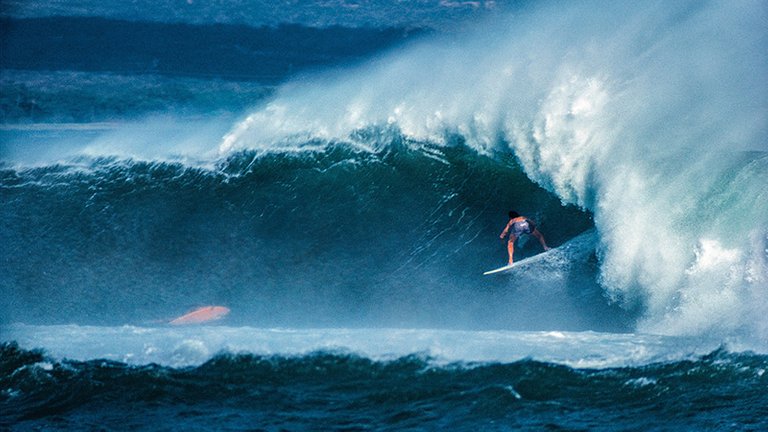
Picture by Herbie Fletcher
The Surf Break "Freight Trains" can go years without breaking, but when it does (the jewel in the crown), my friends, it becomes one of the most respected and challenging waves in the world. For decades, there were expansion plans for the nearby port that threatened the waves in the area, and approved projects jeopardized the local nature.
It took years of struggle and close attention to government movements to prevent this destruction from happening. Meetings, procedures, and discussions occurred in abundance during the 80s to put on the table the possibility of port expansion and the exposure of ideas from both sides of the coin - Money and Tourism & Nature, the local community, and sports enthusiasts.
Ten years ago, the admirers of this place, its history, and the wave often referred to as having the "speed of a freight train" tasted victory. The Department of Land and Natural Resources of Hawaii and the U.S. Army Corps of Engineers abandoned the plans for the extension of the breakwater at Ma'alaea Harbor.
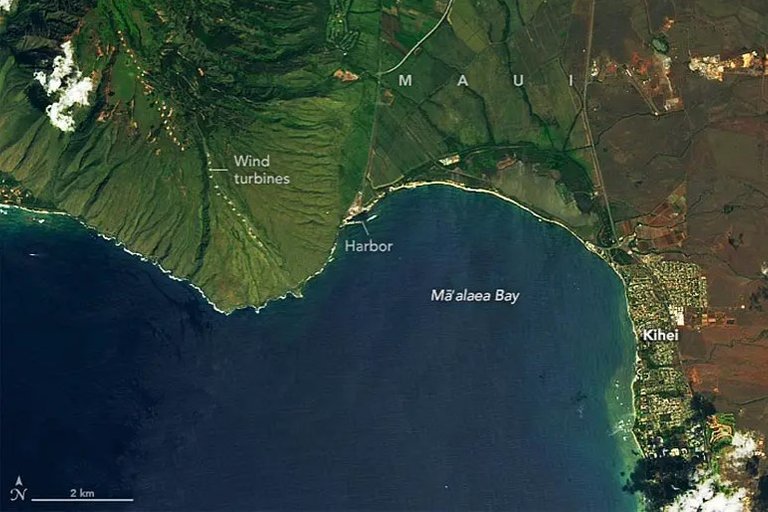
Mã'alaea Bay View Nasa
Normally, Maui isn't in the world surf news cycle in July. But the Code Red 2 swell, which we first saw producing all-time waves at Teahupo'o, wasn't just an ordinary swell. This is why this energy and how it made headlines (and history) as it hit the south-facing shores of Maui.
The Ma'alaea Bay trains are a delicate wave - one of those spots that require many combined conditions to work perfectly. The waves have to split a narrow gap between the south part of Maui and the volcanic island of Kaho'olawe. This same pulse must also fly over the Molokini Crater with enough energy intact to turn Freight Trains into what is considered one of the fastest waves in the world. There's a gap of about 10 or 11 kilometers that all this energy needs to navigate with the kind of precision that turns the trains into the barrels we saw that weekend. How rare is all of this? Even though the wave itself breaks from time to time, even Kai Lenny had never surfed this spot on his home island.
"It was 4 to 6 feet in the morning and jumped to solid 2.5 meters with bigger sets around 2 p.m.," said cinematographer Marcus Rodriguez to The Inertia, who called it the biggest day(s) there in 20 years.
When big waves break in Ma'alaea Bay, they do so with the crushing speed of a freight train.
Faster than a locomotive
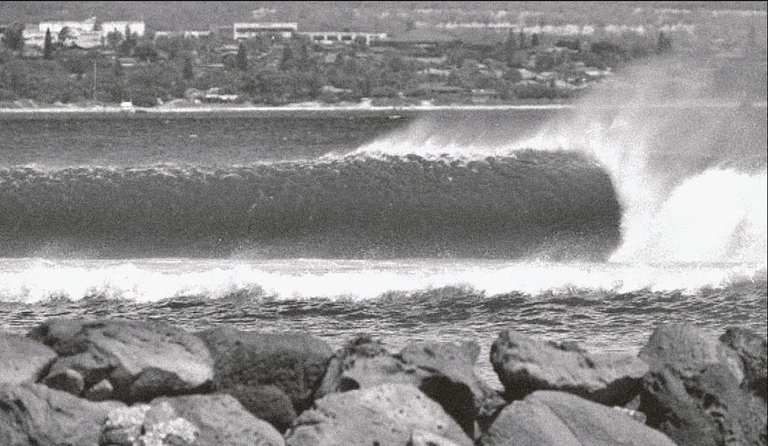
"Freight Trains" and "Jaws" may sound like summer blockbuster hits like corny movies and other projects, but the names belong to two of the most iconic waves on the island of Maui. They are revered by surfers for a good reason. Freight Trains has been considered one of the fastest surfable waves in the world, while Jaws, along with Nazaré, is globally recognized in the 'Big Wave' world.
The surf break known as the “Freight Trains” crosses Māʻalaea Bay on the south coast of Maui. However, for these classic fast right barrels to break on the bench the conditions need to be perfect… Swell Quadrant South/Southeast Solid.
Big waves, or swells, are typically generated in the Southern Hemisphere during the winter when big storms form in the South Pacific Ocean. Waves can travel thousands of miles, crossing the equator and finally reaching the south coast of Maui, where it's summer. But waves can lose energy along the way as they encounter various island chains in the South Pacific.
Maui's iconic waves break with the crushing speed of a freight train.
In the area where the break lies, there is a small port for boats of the State of Hawaii (Ma'alaea) that has been living a long drama. Expansion plans have existed for over 30 years, but they have not been without controversy.
In fact, there are several surf breaks directly in front of the port wall, but the area that would be most affected by the proposed expansion is, in fact, Freight Trains. When the wave works, legendary surfers from all over the world grab their best boards and share this natural gift - truly incredible.
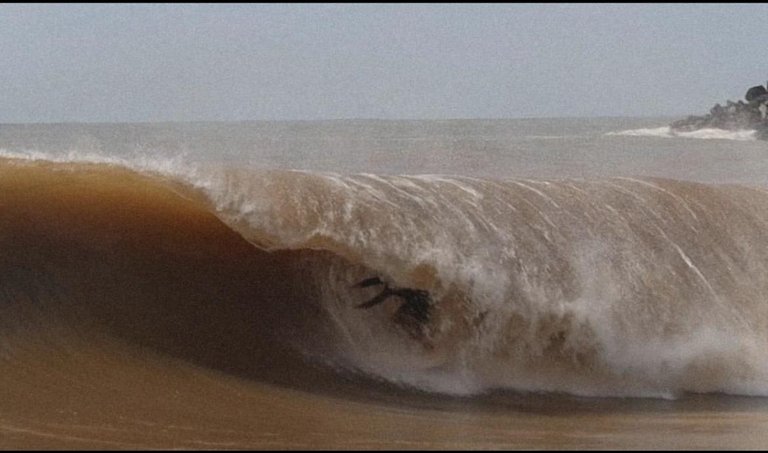
Frame by Thiago Souza, ITEM Filmes, Short Movie ''Oke Oke''| Surfer Rodrigo Cardoso [SECRET]
Let's move on to a valuable account by Gerry Lopez in his book
'' The United States Army Corps of Engineers has been at the forefront of this and all other projects along the State's coast. Their track record has been, generously speaking, somewhat questionable. Surfers were not happy when the Tragic Magic Island was built in the 1960s directly over a very consistent and excellent surf spot called Garbage Hole, along with other popular surf breaks in the immediate area. Shortly after, the Corps of Engineers removed another great wave at the famous Maile Cloudbreak by building a drainage channel.
In the 1980s, the Ma'alaea Harbor expansion project received federal funding, and the State of Hawaii was eager to begin construction within a required timeframe to avoid the risk of losing government grant money. The Department of Land and Natural Resources, Division of Harbors, along with representatives from the Army Corps of Engineers, held a public meeting at Kihei School.
This is a standard practice to allow affected parties of any public project to ask questions and express their complaints. Those in favor of the expansion, of course, are the boat owners who are crowded into the small harbor. Many operate fishing, diving, or tourist excursion boats. These businesses became very popular in the 1980s with the rapid growth of Maui Island.
The most vocal, however, are the local fishermen for whom the harbor was originally built. They are being displaced from their harbor berths as larger and better-financed tourist operations receive berths. The surfers and concerned property owners who live in condos and houses near the beach also oppose the expansion.
The protocol is that anyone who wants to speak must sign up on a list and wait to be called. The representatives of the Department of Land and Natural Resources and the Army Corps of Engineers spoke first. They talked about the growing need for more space in the harbor and showed some preliminary plans on how they intend to address these needs. Their plans were to extend the existing breakwater wall toward Kihei, running right over the entire Freight Trains surf spot.
After their presentation, the government representatives explained how the rest of the meeting would work and began calling those who had signed up. Several boat owners spoke about the lack of space and the long waiting list for those wanting a harbor berth. Some condo owners asked the Division of Harbors representative how the new harbor would affect their properties; according to the proposed plan, the boat berths would replace the sandy beach area. A surfer stood up to state that the breakwater would permanently erase one of the island's best surf spots, but before he could finish, boos and jeers were heard from the back of the room. Several local fishermen and boat owners were quite drunk before the meeting, drinking throughout the afternoon before the 8 p.m. meeting. They were very vocal in opposition to any opposition to what they wanted. It saddened me knowing that they would be the last ones to benefit from a larger harbor. High-end tourist operations would undoubtedly have priority.
John Kelly, from Save Our Surf, flew over there that afternoon to attend the meeting. I arrived just after the meeting began and had no time to socialize or see who else was there. I was surprised, but excited, to learn that the great champion of surfers' cause for the past 25 years was about to speak. He had been involved in the Ma'alaea project from the beginning.
I knew John well from surfing; I went to high school with his daughters and supported all his efforts to preserve surf spots throughout the state. As he stepped up to the podium, I was sure he would present a reasonable historical perspective that would reveal the foolishness of this latest plan for the harbor.
John started by saying he came from O'ahu to be there but, feeling that he was against the new harbor, the provocateurs began shouting at him to go back. John looked at the representatives of the Department of Land and Natural Resources and the Army Corps of Engineers, who supposedly led the meeting, to take action and allow him to speak. But I could see from their superior air that this was exactly what they wanted. They didn't want any opposition to what they planned. The noise level got so high and angry that it seemed the situation was about to turn into something violent and physical. John Kelly had no choice but to sit back down. It was a sad moment.
Next, it was probably the oldest person in the room's turn to speak. It was Woody Brown, an old friend of John Kelly's. I knew Woody lived in Kahului and was sure they had come to the meeting together. Woody and John, along with George Downing, Wally Froiseth, Fran Heath, and others, were the pioneers who paved the way for big wave surfing. Their story was colorful and wonderful at the beginning of the modern era of surfing in Hawaii.
Woody was in his eighties, and his seemingly fragile appearance concealed a quick and sharp mind. As he walked up to the podium, the entire meeting quieted in deference to his age. None of the boat owners, especially the drunks, knew who he was or which side he was on.
Woody stood tall and looked at the crowd, the sparkle in his eyes obvious to everyone. As he began speaking in his soft voice and calm manner, the audience grew even quieter to hear what he had to say. He spoke of a time long before the harbor existed, of spending time on the sandy beach with his Hawaiian wife, fishing, surfing the waves, and enjoying the beautiful and idyllic place. He spoke of other Hawaiian and local families who also enjoyed the place and the moments they shared there.
The attention in the room was completely focused as Woody took us to a place and time of a natural Ma'alaea that none of us knew had existed. He paused and let the moment he had transported everyone to sink into our hearts and minds.
Then he added, "I remember the first time the government came to Ma'alaea. I was there."
Woody paused again and gave a look to the sitting officials that I interpreted not as disdain, but as pity. The two government men seemed to shrink under his calm and firm gaze, checking their shoelaces and nails.
Looking back at the silent group, he concluded by saying, "The first thing they did was build a restroom right on top of the freshwater spring."
As he sat down, silence still permeated the entire crowd, while the government men squirmed in their seats and even the chatters looked at each other shyly, forgetting about their beers.
Now, almost 20 years after that meeting, the Surfrider Foundation got involved and is monitoring the ongoing plans of the State of Hawaii for harbor expansion. I'm glad to inform you that, so far, the government has not built anything over the surf spot. Ma'alaea Freight Trains has had several epic sessions in recent seasons. The fastest wave in the world still lives, at least for now. ''
Greetings and appreciation to #gerrylopez, @surfrider, and other groups, volunteers, and activists who fought so hard for the conservation of Freight Trains to become a reality.
Secret, the drama, the Barrel, the split

A curious fact is that when we revisit this story, it's impossible not to remember the case of "Secret," a wave located in the North Shore of Espírito Santo - Brazil, which was destroyed by the industries ports. We notice that this paradox repeats itself and has been going on for years. The state of Espírito Santo has experienced similar drama in various places from North to South, and it still does today. But this wave will indeed be missed. A true stone bottom with a usually brown and perfect tube, with a breathtaking landscape in an indigenous reserve rich in nature.
Today, the wave has died, the reef already suffers, and there's a lateral triangle near the pier that's very difficult to surf, with deforestation present all around.
Some time ago, I was in Ericeira, Portugal, surfing another "secret" spot, when an Italian friend on a Single fin came gliding in the tube. We started talking, and when I introduced myself, wouldn't you believe it, Dado @shredpork knew the region where I live precisely because of the Secret?
 Art by Dado Art by Dado | 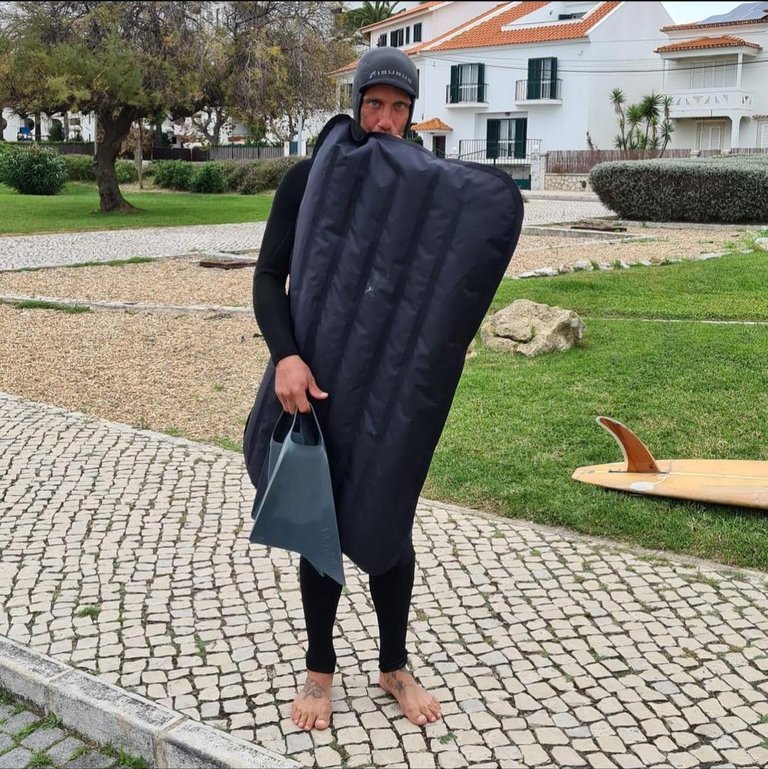 Dado's War Tool Dado's War Tool |
|---|
What few people know is that this wave was one of the best waves in Brazil, and the local community of Aracruz has been riding this epic wave for a long time. It was during the final scenes of the spot that surfers from outside started coming on specific days to catch the best conditions. Unfortunately, it didn't last! SPQV
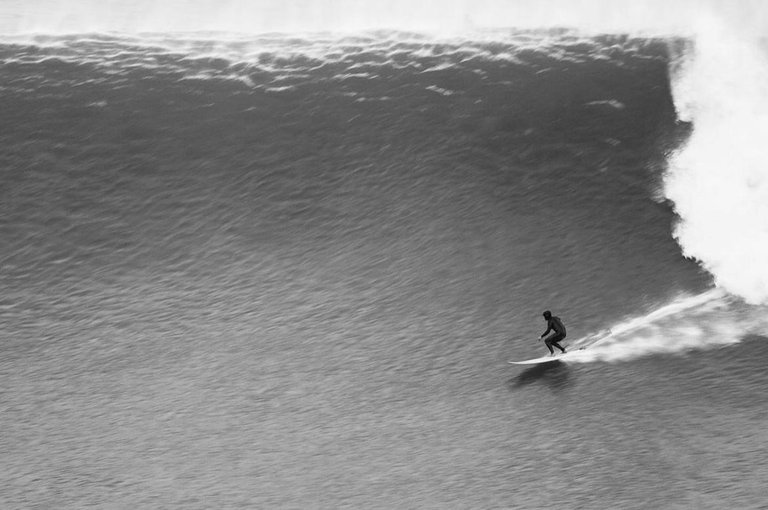
#shredpork picuture by Cristian Corradin, #Ilussionssurfboards 9'6
Now, all these moments experienced in the region have merged into emptiness and become memories... good memories with great reflective power. The enchantment of the sea is intrinsically linked to the preservation of coastal waves, reefs, and shorelines. Through awareness, adopting sustainable practices, and cooperating across all sectors of society, we can ensure that these marine ecosystems remain healthy and abundant. By doing so, we will not only protect marine biodiversity but also secure a promising future for our planet and future generations.
Unity is strength. Giving up is not an option.
In my humble opinion, the story of Freight Trains should be known to inspire surf organizations and sports enthusiasts to establish strength and support in seeking environmental protection and preserving historical surf spots.
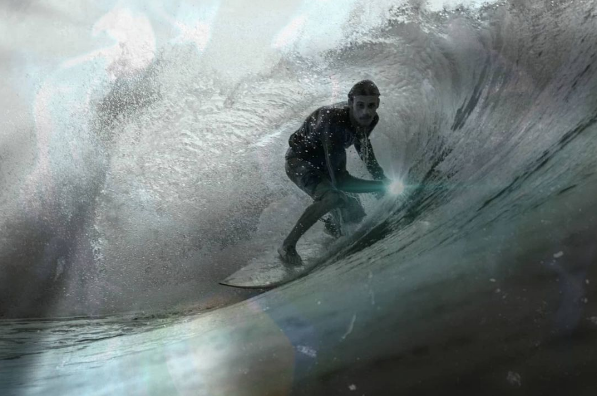
Aloha, guys. I hope you enjoyed it SURF LIFE ARDRP!☯️
[EN/PT-BR] ''Uma história entre uma lendária onda havaiana e uma onda que morreu no sudeste do Brasil.'' ☢️
Português [🇧🇷]
Yooo... Ciao SurFhive!
Hoje, peguei algumas ondas incríveis em um lugar que tem um lugar especial no meu coração, e isso me inspirou a compartilhar este texto com todos vocês!
Julho chegou, e é hora de boas ondas. E não é apenas aqui no Brasil que tivemos boas ondas em julho do ano passado... Algo sério aconteceu em uma localidade remota no Havaí também. Estou me referindo à Costa Sul de Maui, onde a Baía de Ma'alaea testemunhou um raro espetáculo da natureza, em um lugar com características geográficas poderosas e uma rica história de resistência. 🤠

Foto de Herbie Fletcher
O ponto de surfe "Freight Trains" pode passar anos sem funcionar, mas quando o faz (a joia da coroa), meus amigos, ele se torna uma das ondas mais respeitadas e desafiadoras do mundo. Por décadas, havia planos de expansão para o porto próximo que ameaçava as ondas da região, e projetos aprovados colocavam em risco a natureza local.
Foram necessários anos de luta e atenção aos movimentos do governo para evitar que essa destruição acontecesse. Reuniões, procedimentos e discussões ocorreram em abundância durante os anos 80 para colocar na mesa a possibilidade de expansão do porto e a exposição de ideias de ambos os lados da moeda - Dinheiro e Turismo & Natureza, a comunidade local e os entusiastas dos esportes.
Há dez anos, os admiradores desse lugar, sua história e a onda frequentemente referida como tendo a "velocidade de um trem de carga" provaram a vitória. O Departamento de Terras e Recursos Naturais do Havaí e o Corpo de Engenheiros do Exército dos EUA abandonaram os planos de extensão do quebra-mar em Ma'alaea Harbor.

Vista da Baía de Mã'alaea pela Nasa
Normalmente, Maui não está no ciclo de notícias mundiais de surfe em julho. Mas o swell Código Vermelho 2, que vimos pela primeira vez produzindo ondas incríveis em Teahupo'o, não foi um swell comum. É por isso que essa energia e como ela fez manchetes (e história) ao atingir as costas voltadas para o sul de Maui.
As ondas de trem de carga em Ma'alaea são uma onda delicada - um daqueles pontos que exigem muitas condições combinadas para funcionar perfeitamente. As ondas têm que atravessar uma estreita passagem entre a parte sul de Maui e a ilha vulcânica de Kaho'olawe. Essa mesma energia deve também passar sobre o vulcão Molokini com energia suficiente para transformar o "Freight Trains" em uma das ondas mais rápidas do mundo. Há uma distância de cerca de 10 ou 11 quilômetros que toda essa energia precisa percorrer com o tipo de precisão que transforma os trens em tubos que vimos naquele fim de semana. Quão raro é tudo isso? Mesmo que a própria onda quebre de vez em quando, mesmo Kai Lenny nunca tinha surfado esse ponto em sua ilha natal.
"De manhã, estava com 1,2 a 1,8 metros e pulou para sólidos 2,5 metros com séries maiores por volta das 14h", disse o cinegrafista Marcus Rodriguez ao The Inertia, que chamou de o maior dia(s) lá em 20 anos.
Quando as ondas grandes quebram na Baía de Ma'alaea, elas o fazem com a velocidade esmagadora de um trem de carga.
Mais rápido que uma locomotiva

"Freight Trains" e "Jaws" podem parecer títulos de sucessos do verão, como filmes piegas e outros projetos, mas os nomes pertencem a duas das ondas mais icônicas da ilha de Maui. São reverenciadas pelos surfistas por um bom motivo. O "Freight Trains" foi considerado uma das ondas surfáveis mais rápidas do mundo, enquanto Jaws, junto com Nazaré, é reconhecida globalmente no mundo do 'Big Wave'.
O ponto de surfe conhecido como "Freight Trains" cruza a Baía de Māʻalaea, na costa sul de Maui. No entanto, para que esses clássicos tubos direitos e velozes quebrem na bancada, as condições precisam ser perfeitas... Swell no quadrante Sul/Sudeste sólido.
Ondas grandes, ou "swells", são geralmente gerados no Hemisfério Sul durante o inverno, quando grandes tempestades se formam no Oceano Pacífico Sul. As ondas podem viajar milhares de milhas, cruzando o equador e finalmente chegando à costa sul de Maui, onde é verão. Mas as ondas podem perder energia ao longo do caminho, pois encontram várias cadeias de ilhas no Pacífico Sul.
As icônicas ondas de Maui quebram com a velocidade esmagadora de um trem de carga.
Na área onde a quebra acontece, existe um pequeno porto para barcos do Estado do Havaí (Ma'alaea) que tem vivido um longo drama. Planos de expansão existem há mais de 30 anos, mas não têm sido isentos de controvérsias.
De fato, há várias ondas diretamente em frente ao muro do porto, mas a área que seria mais afetada pela expansão proposta é, na verdade, o "Freight Trains". Quando a onda está funcionando, lendários surfistas de todo o mundo pegam suas melhores pranchas e compartilham esse presente natural - verdadeiramente incrível.

Quadro de Thiago Souza, ITEM Filmes, Filme curto ''Oke Oke''| Surfista Rodrigo Cardoso [SECRET]
Vamos para um relato valioso de Gerry Lopez em seu livro
''O Corpo de Engenheiros do Exército dos Estados Unidos esteve na vanguarda deste e de todos os outros projetos ao longo da costa do Estado. Seu histórico tem sido, generosamente falando, um tanto questionável. Os surfistas não ficaram felizes quando a Tragic Magic Island foi construída na década de 1960 diretamente sobre um ponto de surfe muito consistente e excelente chamado Garbage Hole, juntamente com outras populares ondas de surfe na área imediata. Pouco depois, o Corpo de Engenheiros removeu outra ótima onda na famosa Maile Cloudbreak, construindo um canal de drenagem.
Na década de 1980, o projeto de expansão do porto de Ma'alaea recebeu financiamento federal, e o Estado do Havaí estava ansioso para começar a construção dentro de um prazo necessário para evitar o risco de perder dinheiro concedido pelo governo. O Departamento de Terras e Recursos Naturais, Divisão de Portos, juntamente com representantes do Corpo de Engenheiros do Exército, realizou uma reunião pública na Escola de Kihei.
Essa é uma prática padrão para permitir que as partes afetadas de qualquer projeto público façam perguntas e expressem suas reclamações. Os que são a favor da expansão, é claro, são os donos de barcos que estão apinhados no pequeno porto. Muitos operam barcos de pesca, mergulho ou excursões turísticas. Esses negócios se tornaram muito populares nos anos 80 com o rápido crescimento da Ilha de Maui.
Os mais vocais, no entanto, são os pescadores locais para quem o porto foi originalmente construído. Eles estão sendo deslocados de seus lugares no porto à medida que operações turísticas maiores e com melhores finanças recebem lugares no porto. Os surfistas e os proprietários preocupados que moram em condomínios e casas próximas à praia também se opõem à expansão.
O protocolo é que qualquer pessoa que queira falar precisa se inscrever em uma lista e esperar para ser chamado. Os representantes do Departamento de Terras e Recursos Naturais e do Corpo de Engenheiros falaram primeiro. Eles falaram sobre a crescente necessidade de mais espaço no porto e mostraram alguns planos preliminares sobre como pretendem resolver essas necessidades. Seus planos eram estender o muro do quebra-mar existente em direção a Kihei, passando por cima do ponto de surfe "Freight Trains" inteiro.
Depois de sua apresentação, os representantes do governo explicaram como o resto da reunião funcionaria e começaram a chamar aqueles que haviam se inscrito. Vários proprietários de barcos falaram sobre a falta de espaço e a longa lista de espera para aqueles que desejam um lugar no porto. Alguns proprietários de condomínios perguntaram ao representante da Divisão de Portos como o novo porto afetaria suas propriedades; de acordo com o plano proposto, os lugares para os barcos substituiriam a área de praia de areia. Um surfista levantou-se para afirmar que o quebra-mar apagaria permanentemente uma das melhores ondas da ilha, mas antes que ele pudesse terminar, vaias e xingamentos foram ouvidos do fundo da sala. Vários pescadores e donos de barcos locais estavam bem bêbados antes da reunião, bebendo durante toda a tarde antes da reunião às 20h. Eles foram muito vocais em oposição a qualquer oposição ao que eles queriam. Isso me entristeceu sabendo que eles seriam os últimos a se beneficiar de um porto maior. Operações turísticas de alto nível teriam, sem dúvida, prioridade.
John Kelly, da Save Our Surf, voou para lá naquela tarde para participar da reunião. Eu cheguei logo depois de a reunião ter começado e não tive tempo para socializar ou ver quem mais estava lá. Fiquei surpreso, mas animado, ao saber que o grande campeão da causa dos surfistas nos últimos 25 anos estava prestes a falar. Ele estava envolvido no projeto de Ma'alaea desde o início.
Eu conhecia bem John do surfe; fui para a escola com suas filhas e apoiei todos os seus esforços para preservar os pontos de surfe em todo o estado. Conforme ele se aproximava do pódio, eu tinha certeza de que ele apresentaria uma perspectiva histórica razoável que revelaria a tolice desse último plano para o porto.
John começou dizendo que veio de O'ahu para estar ali, mas, sentindo que era contra o novo porto, os provocadores começaram a gritar para que ele voltasse. John olhou para os representantes do Departamento de Terras e Recursos Naturais e do Corpo de Engenheiros do Exército, que supostamente lideravam a reunião, para tomar providências e permitir que ele falasse. Mas pude ver por sua postura superior que isso era exatamente o que eles queriam. Eles não queriam nenhuma oposição ao que planejavam. O nível de ruído aumentou tanto e ficou tão raivoso que parecia que a situação estava prestes a se transformar em algo violento e físico. John Kelly não teve outra escolha senão se sentar novamente. Foi um momento triste.
Em seguida, foi a vez da pessoa mais idosa da sala falar. Era Woody Brown, um velho amigo de John Kelly. Eu sabia que Woody morava em Kahului e tinha certeza de que eles tinham vindo juntos para a reunião. Woody e John, junto com George Downing, Wally Froiseth, Fran Heath e outros, foram os pioneiros que abriram caminho para o surfe de ondas grandes. Sua história foi colorida e maravilhosa no início da era moderna do surfe no Havaí.
Woody tinha oitenta anos, e sua aparência aparentemente frágil escondia uma mente rápida e afiada. Quando ele se aproximou do pódio, toda a reunião se aquietou em deferência à sua idade. Nenhum dos donos de barco, especialmente os bêbados, sabia quem ele era ou de que lado estava.
Woody ficou alto e olhou para a multidão, o brilho em seus olhos óbvio para todos. Quando ele começou a falar em sua voz suave e calma, a plateia ficou ainda mais quieta para ouvir o que ele tinha a dizer. Ele falou de um tempo muito antes de existir o porto, de passar um tempo na praia de areia com sua esposa havaiana, pescando, surfando nas ondas e aproveitando o lugar bonito e idílico. Ele falou de outras famílias havaianas e locais que também apreciavam o lugar e os momentos que compartilhavam ali.
A atenção na sala estava completamente focada enquanto Woody nos levava a um lugar e momento de um Ma'alaea natural que nenhum de nós sabia que tinha existido. Ele fez uma pausa e deixou o momento que havia transportado a todos afundar em nossos corações e mentes.
Então ele acrescentou: "Lembro-me da primeira vez que o governo veio a Ma'alaea. Eu estava lá."
Woody fez outra pausa e lançou um olhar aos oficiais sentados que interpretei não como desdém, mas como piedade. Os dois homens do governo pareciam encolher sob seu olhar calmo e firme, verificando seus cadarços e unhas.
Olhando para o grupo silencioso, ele concluiu dizendo: "A primeira coisa que eles fizeram foi construir um banheiro bem em cima da nascente de água doce."
Enquanto ele se sentava, o silêncio ainda permeava toda a multidão, enquanto os homens do governo se contorciam em seus assentos e até os conversadores olhavam timidamente uns para os outros, esquecendo de suas cervejas.
Agora, quase 20 anos após aquela reunião, a Surfrider Foundation se envolveu e está acompanhando os planos em andamento do Estado do Havaí para a expansão do porto. Fico feliz em informar que, até agora, o governo não construiu nada sobre o ponto de surfe. Os "Freight Trains" de Ma'alaea tiveram várias sessões épicas nas últimas temporadas. A onda mais rápida do mundo ainda vive, pelo menos por enquanto.''
Saudações e apreço a #gerrylopez, @surfrider e outros grupos, voluntários e ativistas que lutaram tão arduamente pela preservação do "Freight Trains" se tornar uma realidade.
Segredo, o drama, o tubo, a partida

Um fato curioso é que, quando revisitamos esta história, é impossível não lembrar do caso de "Secret", uma onda localizada no litoral norte do Espírito Santo - Brasil, que foi destruida por obras industriais ao redor da costa. Notamos que esse paradoxo se repete e tem ocorrido há anos. O estado do Espírito Santo tem vivenciado dramas semelhantes em vários locais, do Norte ao Sul, e ainda os vivencia hoje. Mas essa onda certamente fará falta. Um verdadeiro fundo rochoso com um tubo geralmente perfeito e marrom, com uma paisagem deslumbrante em uma reserva indígena rica em natureza.
Hoje, a onda morreu, o recife já sofre e há um triângulo lateral perto do píer que é muito difícil de surfar, com desmatamento presente por toda a região.
Algum tempo atrás, eu estava em Ericeira, Portugal, surfando outro ponto "secreto", quando um amigo italiano em uma prancha Single fin deslizou no tubo. Começamos a conversar, e quando me apresentei, você não vai acreditar, Dado @shredpork conhecia a região e também o lugar que havia sido enterrado. Um italiano e um brasileiro falando de um ponto perdido no litoral do Brasil em uma onda secreta? Haha, o mundo é mesmo muito pequeno.
 Art by Dado Art by Dado |  Dado's War Tool Dado's War Tool |
|---|
Quando pensamos no valor do surf para a comunidade, é importante perceber que essa não é apenas uma prática esportiva, mas também uma parte cultural, social e ambientalmente relevante. A preservação de lugares como o "Freight Trains" e "Secret" vai além do simples prazer de surfar, é um cuidado com a natureza e com a história que essas ondas carregam.
O que poucos sabem é que essa onda foi uma das melhores do Brasil, e a comunidade local de Aracruz vem pegando essa onda épica há muito tempo. Foi nas cenas finais do spot que os surfistas de fora começaram a vir em dias específicos para pegar as melhores condições. Infelizmente não durou! SPQV

imagem #shredpork por Cristian Corradin, #Ilussionssurfboards 9'6
Agora, todos esses momentos vividos na região se fundiram no vazio e viraram lembranças... boas lembranças com grande poder reflexivo. O encantamento do mar está intrinsecamente ligado à preservação das ondas, recifes e orlas costeiras. Por meio da conscientização, da adoção de práticas sustentáveis e da cooperação em todos os setores da sociedade, podemos garantir que esses ecossistemas marinhos permaneçam saudáveis e abundantes. Ao fazer isso, não apenas protegeremos a biodiversidade marinha, mas também garantiremos um futuro promissor para nosso planeta e para as gerações futuras.
Unidade é força. Desistir não é uma opção.
Na minha humilde opinião, a história dos Freight Trains deve ser conhecida para inspirar organizações de surf e entusiastas do esporte a estabelecer força e apoio na busca de proteção ambiental e preservação de pontos históricos de surf.
Os surfistas são embaixadores do oceano, defensores do meio ambiente e conscientes da importância de proteger esses tesouros naturais. Podemos surfar em ondas incríveis, mas também temos a responsabilidade de garantir que as gerações futuras também possam desfrutar dessas maravilhas.
Que continuemos a lutar pela proteção de lugares especiais como esses, pois eles são um patrimônio natural que merece ser preservado para as próximas gerações.
Lembre-se de que, embora tenha um mar inteiro para surfar, a perda de uma única onda já é uma grande derrota.
E aí, qual é a sua onda favorita e o que você tem feito para ajudar a preservá-la?
Abraços oceânicos e até a próxima!🤙

Cara. Que post sensacional! Eu acompanhei quase que de perto a história dessa onda no ES, e quando eu soube da história e de tudo o que aconteceu, que já era tarde, fiquei muito triste. As vezes chego a pensar que a onda era tão secreta, que por não ser conhecida, não tinha “importância” local e por isso acabou sendo destruída. Mas fica aí a lição e o aprendizado pra protegermos outras ondas no Brasil!
Woww, que massa Criscia!!! Esse lugar é mágico.... Fica o aprendizado para nós e os bons momentos. alohaa!!!!
Obrigado por promover a comunidade Hive-BR em suas postagens.
Vamos seguir fortalecendo a Hive
Your post was manually curated by @Shiftrox.
Delegate your HP to the hive-br.voter account and earn Hive daily!
🔹 Follow our Curation Trail and don't miss voting! 🔹
Congratulations @joaoparmagnani! You have completed the following achievement on the Hive blockchain And have been rewarded with New badge(s)
Your next target is to reach 4250 upvotes.
You can view your badges on your board and compare yourself to others in the Ranking
If you no longer want to receive notifications, reply to this comment with the word
STOPCheck out our last posts: